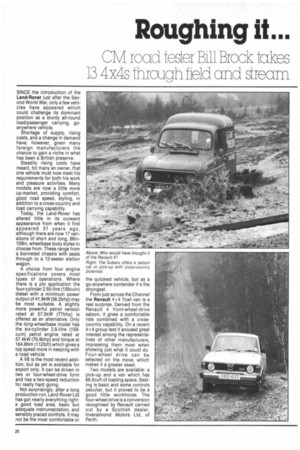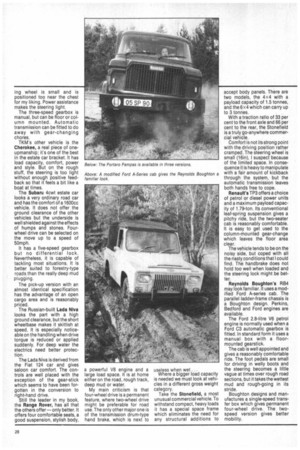Roughing it...
Page 142

Page 143

Page 144

If you've noticed an error in this article please click here to report it so we can fix it.
CV road -tes[er Bill Broci.c. ta-ces 13 4x4s -t-rroJgia field ca-rct s[recr_m_ SINCE the introduction of the Land-Rover just after the Second World War, only a few vehicles have appeared which could challenge its dominant position as a sturdy all-round loadipassenger carrying, goanywhere vehicle.
Shortage of supply, rising costs, and a change in demand have, however, given many foreign manufacturers the chance to gain a niche in what has been a British preserve.
Steadily rising costs have meant, for many an owner, that one vehicle must now meet his requirements for both his work and pleasure activities. Many models are now a little more up-market, providing comfort, good road speed, styling, in addition to a cross-country and load carrying capability.
Today, the Land-Rover has altered little in its outward appearance from when it first appeared 31 years ago, although there are now 17 variations of short and long. 88in109in, wheelbase body styles to choose from. These range from a bonneted chassis with seats through to a 12-seater station wagon.
A choice from four engine specifications covers most types of operations. Where there is a pto application the four-cylinder 2.55-litre (156cuin) diesel with a minimum power output of 41.9kW (56.2bhp) may be most suitable. A slightly more powerful petrol version rated at 57.5kW (77bhp) is offered as an alternative. Only the long-wheelbase model has the six-cylinder 2.6-litre (159cuin) petrol engine rated at 57.4kW (76.9bhp) and torque at 164.8Nm (112Ibft) which gives a top speed more in keeping with a road vehicle.
A V8 is the most recent addition, but as yet is available for export only. It can be driven in two or four-wheel-drive form and has a two-speed reduction for really hard going.
Not surprisingly, after a long production run, Land-Rover Ltd has got nearly everything right: a good load area, basic but adequate instrumentation, and sensibly placed controls. It may not be the most comfortable or the quickest vehicle, but as a go-anywhere contender its the strongest.
From just across the Channel the Renault 4x4 7cwt van is a real surprise. Derived from the Renault 4 front-wheel-drive saloon, it gives a comfortable ride combined with a crosscountry capability. On a recent 4<4 group test it aroused great interest among the representatives of other manufacturers, impressing them most when showing just what it could do. Four-wheel drive can be selected on the move, which makes it a greater asset.
Two models are available: a pick-up and a van which has 66.5cuft of loading space. Seating is basic and some controls peculiar, but it proved to be a good little workhorse. The four-wheel drive is a conversion recognised by Renault carried out by a Scottish dealer, Inveralmond Motors Ltd, of Perth. BAJA four-wheel-drive conversions have been available in the USA for Japanese one-ton pick-ups for over five years and now operate in the UK from Henley-on-Thames, Oxfordshire.
I tried out a Mazda B 1800. The body, located much higher owing to modifications made to the sub-frame and suspension, gives the impression of a lot of ground clearance under the vehicle's belly.
Where it does fall down is with the clearance beneath the differential of each axle, which can lead to problems on heavily rutted tracks. I got stuck and had to be winched off. No matter how good the drive, if the wheels don't touch the ground the vehicle doesn't move.
As an independent conversion it is a bit untidy, but it coped with most obstacles, including the deep water holes, of which it made heavy weather at times. The steering was tight and this one-ton pick-up could do with better seats. Its main advantage over other vehicles of its size is its good payload capacity.
The conversion is also available for the Datsun and at one time the Toyota, which now does its own four-wheel drive vehicle. Based on the Hi-lux and powered by a two-litre petrol engine, this model gives a payload of over one ton.
Built in Portugal, the Portaro Pampas, imported by Land Car Concessionaires of 9 Hanover Street, London, comes in three versions — a hardtop, canvas top and as a closed cab pick-up. The engine is a 2.5-litre diesel unit, and with a minimum output of 60kW (80bhp) this gives claim to a maximum road speed of about 70mph.
The main gearbox has synchromesh on all four forward gears while a transfer box provides high and low range. Free-wheeling hubs are included on the front axle. Built in the Land-Rover image, it may well secure sales with those who want a fairly basic machine with a payload capability of 700kg (14 cwt).
The Daihatsu 4 x 4 is a remarkable little machine, purpose built, and it looks like a scaled down Jeep with an open top covered by a canvas hood. It offers a choice of engine — a slightly more powerful 1.6-litre four-cylinder petrol rated at 50kW (67bhp) or the initially more expensive 2.5-litre diesel, which costs less to run.
The Jeep Renegade is imported from the States by TKM Vehicle Services (UK) Ltd, of St James Street, London, as well. Here we are progressing into a different class, primarily for go-anywhere pleasure vehicles. It is very manoeuvrable, with a 4.2-litre six-cylinder engine in standard form, or a five-litre V8 engine as an option. It gives a very firm ride, but the seats are well padded, the steer ing wheel is small and is positioned too near the chest for my liking. Power assistance makes the steering light.
The three-speed gearbox is manual, but can be floor or column mounted. Automatic transmission can be fitted to do away with gear-changing chores.
TKM's other vehicle is the Cherokee, a real piece of oneupmanship ; its one of the best in the estate car bracket. It has load capacity. comfort, power and style. But on the rough stuff, the steering is too light without enough positive feedback so that it feels a bit like a boat at times.
The Subaru 4ewt estate car looks a very ordinary road car and has the comfort of a 1600cc vehicle. It does not offer the ground clearance of the other vehicles but the underside is well shielded against the effects of humps and stones. Fourwheel drive can be selected on the move up to a speed of 50m ph.
It has a five-speed gearbox but no differential lock. Nevertheless, it is capable of tackling most situations. It is better suited to forestry-type roads than the really deep mud plugging.
The pick-up version with an almost identical specification has the advantage of an open cargo area and is reasonably priced.
The Russian-built Lade Niva looks the part with a high ground clearance, but the short wheelbase makes it skittish at speed. It is especially noticeable on the handling when drive torque is reduced or applied suddenly. For deep water the electrics need better protection.
The Leda Niva is derived from the Fiat 124 car and gives saloon car comfort. The controls are well placed with the exception of the gear-stick which seems to have been forgotten in the conversion to right-hand drive.
Still the leader in my book, the Range Rover, has all that the others offer —only better. It offers four comfortable seats, a good suspension, stylish body, a powerful VS engine and a large load space. It is at home either on the road, rough track, deep mud or water.
My main criticism is that four-wheel drive is a permanent feature, where two-wheel drive might be preferable for road use. The only other major one is of the transmission drum-type hand brake, which is next to useless when wet ...
Where a bigger load capacity is needed we must look at vehicles in a different gross weight category.
Take the Stonefield, a most unusual commercial vehicle. To withstand compact, heavy loads it has a special space frame which eliminates the need for any structural additions to accept body panels. There are two models, the 4x4 with a payload capacity of 1.5 tonnes, and the 6 x 4 which can carry up to 3 tonnes.
With a traction ratio of 33 per cent to the front axle and 66 per cent to the rear, the Stonefield is a truly go-anywhere commercial vehicle.
Comfort is not its strong point with the driving position rather cramped. The steering wheel is small (16in), I suspect because of the limited space. In consequence it is heavy to manipulate with a fair amount of kickback through the system, but the automatic transmission leaves both hands free to cope.
Renault's 1P3 offers a choice of petrol or diesel power units and a maximum payload capacity of 1.79-ton. Its conventional leaf-spring suspension gives a pitchy ride, but the two-seater cab is reasonably comfortable. It is easy to get used to the column-mounted gear-change which leaves the floor area clear.
The vehicle tends to be on the noisy side, but coped with all the nasty conditions that I could find. The handbrake does not hold too well when loaded and the steering lock might be better.
Reynolds Boughton's RB4 may look familiar. It uses a modified Ford A-series cab. The parallel ladder-frame chassis is a Boughton design. Perkins, Bedford and Ford engines are available.
The Ford 2.8-litre V6 petrol engine is normally used when a Ford C3 automatic gearbox is fitted. In standard form it uses a manual box with a floormounted gearstick.
The cab is well appointed and gives a reasonably comfortable ride. The foot pedals are small for driving in welly boots and the steering becomes a little vague at times over rough road sections, but it takes the wettest mud and rough-going in its stride.
Boughton designs and manufactures a single-speed transfer box which gives permanent four-wheel drive. The twospeed version gives better mobility.




























































































































































